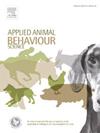马主报告的被骑马匹行为的品种差异
IF 2.2
2区 农林科学
Q1 AGRICULTURE, DAIRY & ANIMAL SCIENCE
引用次数: 0
摘要
家马通常根据轶事品种特定的行为特征选择特定的活动,其中一些是在竞争环境中测试的,其中许多与人类安全有关。另一方面,品种通常以其多功能性而闻名。本研究的目的是通过马行为评估和研究问卷(E-BARQ)调查马的饲养员(“主人”)所报告的被骑马行为的品种差异。从E-BARQ数据库中的一组车主报告(n = 8151)中,选择标准适用于报告如下:纯种;最近六个月内骑过的马;如果每匹马有多个记录,则只记录该马的第一个记录;而且只有至少35匹马的品种。这为当前的研究提供了1635匹马的报告样本。考虑了先前报道的14种行为结构,即可训练性,安全骑乘,大胆,易于处理,易于骑乘,易于停止,不太可能失速(不太可能退缩),可接近,大胆与非人类,对新物体的信心,对触觉刺激的耐受性,易于加载,对孤立和重复行为的耐受性。对于每一个结构,一个有序的逻辑回归模型拟合得分数据,品种作为解释变量。结果证实,14个品种在14个构造分数中有12个存在显著差异,例外是易于处理和与非人类的大胆。根据品种不同,表现出最大差异的构念是重复行为。正如预期的那样,有一些弱聚类的构念,如安全、容易骑、容易停车和不太可能失速。这些特征使骑马变得有用。此外,目前的研究结果表明,马行为学家应该考虑他们的病人的E-BARQ档案,以确定他们与一个品种的平均水平有多大的不同。随着对特定品种马的典型行为的更多了解,训练师和骑手将能够调整他们的训练和管理技术,以更好地适应他们的马。本文章由计算机程序翻译,如有差异,请以英文原文为准。
Owner-reported breed differences in the behaviour of ridden horses
Domestic horses are often selected for specific activities according to anecdotal breed-specific behavioural traits some of which are tested in competition environments and many of which relate to human safety. On the other hand, breeds are often celebrated for their versatility. The purpose of the current study was to investigate breed differences in ridden horse behaviour, as reported by horse carers (“owners”) through the Equine Behaviour Assessment and Research Questionnaire (E-BARQ). From a pool of owners’ reports (n = 8151) in the E-BARQ database, selection criteria were applied to reports as follows: purebred only; horse ridden within the last six months; only the first record of the horse taken if there were multiple records per horse; and only breeds with at least 35 horses. This generated a sample of reports on 1635 horses for the current study. Fourteen previously reported behavioural constructs were considered, namely trainability, safe to ride, boldness, easy to handle, easy to ride, easy to stop, unlikely to stall (unlikely to baulk), approachable, bold with non-humans, novel object confidence, tolerance of tactile stimulation, easy to load, tolerance of isolation and repetitive behaviours. For each of these constructs, an ordinal logistic regression model was fitted to the score data, with breed as the explanatory variable. The results confirmed that there were significant differences among the 14 breeds in 12 of the 14 construct scores, the exceptions being easy to handle and boldness with non-humans. The constructs that showed the most difference according to breed were repetitive behaviours. As expected, there was some weak clustering of constructs, e.g. safe, easy to ride, easy to stop, and unlikely to stall. These are the traits that make riding horses useful. Furthermore, the current findings suggest that equine behaviourists should consider E-BARQ profiles of their patients to establish how different they are from a breed average. With more knowledge surrounding what is typical behaviour for particular horse breeds, trainers and riders will be able to adjust their training and management techniques to better suit their individual horses.
求助全文
通过发布文献求助,成功后即可免费获取论文全文。
去求助
来源期刊

Applied Animal Behaviour Science
农林科学-行为科学
CiteScore
4.40
自引率
21.70%
发文量
191
审稿时长
18.1 weeks
期刊介绍:
This journal publishes relevant information on the behaviour of domesticated and utilized animals.
Topics covered include:
-Behaviour of farm, zoo and laboratory animals in relation to animal management and welfare
-Behaviour of companion animals in relation to behavioural problems, for example, in relation to the training of dogs for different purposes, in relation to behavioural problems
-Studies of the behaviour of wild animals when these studies are relevant from an applied perspective, for example in relation to wildlife management, pest management or nature conservation
-Methodological studies within relevant fields
The principal subjects are farm, companion and laboratory animals, including, of course, poultry. The journal also deals with the following animal subjects:
-Those involved in any farming system, e.g. deer, rabbits and fur-bearing animals
-Those in ANY form of confinement, e.g. zoos, safari parks and other forms of display
-Feral animals, and any animal species which impinge on farming operations, e.g. as causes of loss or damage
-Species used for hunting, recreation etc. may also be considered as acceptable subjects in some instances
-Laboratory animals, if the material relates to their behavioural requirements
 求助内容:
求助内容: 应助结果提醒方式:
应助结果提醒方式:


